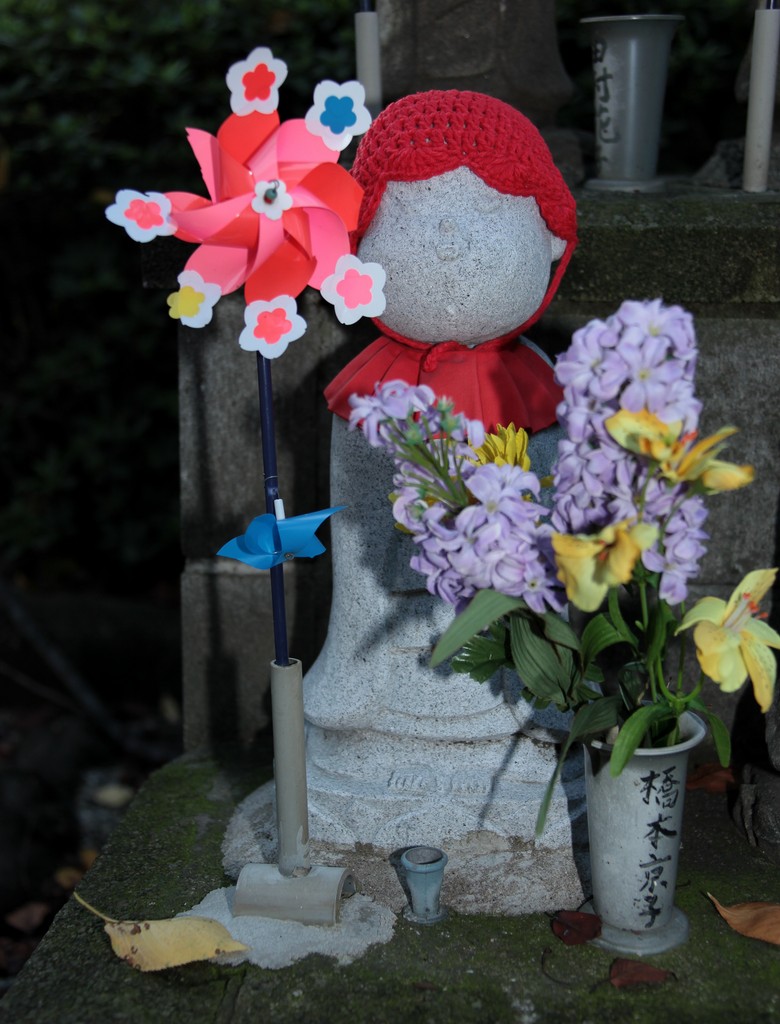JIZO STATUE AT ZOJO-JI TEMPLE
Le Mizuko kuyō (水子供養) ou "cérémonie à la mémoire de fœtus", est une cérémonie japonaise destinée aux femmes qui ont eu une fausse couche, un avortement ou une mortinaissance. Cette pratique s’est fortement développée depuis les années 1970 avec la création de temples spécifiquement destinés à ce rituel. Ces rites se sont développés pour faire face au chagrin des parents, pour assurer le repos de l’âme de fœtus, ou pour éviter la vengeance de son esprit.
Le terme japonais Mizuko (水子), prononcé suiji en sino-japonais, qui signifie mot-à-mot "enfant de l’eau", est utilisé en japonais pour le fœtus sans vie. En japonais ancien, il signifiait également le très jeune enfant décédé et était à l’origine un kaimyō (戒名), nom posthume. Le terme bouddhiste kuyō (供養), qui signifiait à l’origine l’offrande de don à un bonze signifie aujourd’hui une cérémonie mortuaire.
La cérémonie mizuko kuyō est l’occasion de faire des offrandes à Jizō (地蔵) un bodhisattva protecteur des enfants. Pendant l’époque d'Edo la cérémonie se pratiquait également par les familles incapables de nourrir leurs enfants et qui étaient poussées par la famine à l’avortement et à l’infanticide.
De nos jours, la pratique du mizuko kuyō continue au Japon, mais sa relation avec la doctrine bouddhiste est devenue plus ténue. On trouve également des cérémonies mizuko kuyō en Corée et dans les communautés japonaises des États-Unis. Le détail des cérémonies varie d’un temple à l’autre et d’une école bouddhique à l’autre. Dans certains temples, des statues de Jizō sont mises en vente. Celles-ci sont habillées de vêtements et de chapeaux rouges et exposées dans la cour du temple.
Des analystes critiquent le comportement de certains temples, jouant sur la peur de beaucoup de japonais que les esprits des morts ne viennent les tourmenter. D’autres considèrent que les temples ne font que satisfaire les besoins exprimés par les fidèles.
--------------------------------------------
Mizuko kuyō (水子供養) or "fetus memorial service", is a Japanese ceremony for those who have had a miscarriage, stillbirth, or abortion. This practice has become particularly visible since the 1970s with the creation of shrines devoted solely to this ritual. Reasons for the performance of these rites can include parental grief, desire to comfort the soul of the fetus, or even fear of retribution from the vengeful spirit.
Mizuko
Mizuko (水子), literally "water child", is a Japanese term for a dead fetus or, archaically, a dead baby or infant. Previously read suiji, the Sino-Japanese on'yomi reading of the same characters, the term was originally a kaimyō (posthumous name) given after death. The mizuko kuyō ceremony was used to make offerings to Jizō, a bodhisattva who is believed to protect children. In the Edo period, when famine sometimes led the poverty-stricken to infanticide and abortion, the practice was adapted to cover these situations as well. Today, the practice of mizuko kuyō continues in Japan, although it is unclear whether it is a historically authentic Buddhist practice. Specifics of the ceremony vary from temple to temple, school to school, and individual to individual. It is common for temples to offer Jizō statues for a fee, which are then dressed in red bibs and caps, and displayed in the temple yard. American religious scholars have criticized the temples for allegedly abusing the Japanese belief that the spirits of the dead retaliate for their mistreatment, but other scholars believe the temples are only answering the needs of the people.
--------------------------------------------
Mizuko kuyō (水子供養) or "fetus memorial service", is a Japanese ceremony for those who have had a miscarriage, stillbirth, or abortion. This practice has become particularly visible since the 1970s with the creation of shrines devoted solely to this ritual. Reasons for the performance of these rites can include parental grief, desire to comfort the soul of the fetus, or even fear of retribution from the vengeful spirit.
Mizuko
Mizuko (水子), literally "water child", is a Japanese term for a dead fetus or, archaically, a dead baby or infant. Previously read suiji, the Sino-Japanese on'yomi reading of the same characters, the term was originally a kaimyō (posthumous name) given after death. The mizuko kuyō ceremony was used to make offerings to Jizō, a bodhisattva who is believed to protect children. In the Edo period, when famine sometimes led the poverty-stricken to infanticide and abortion, the practice was adapted to cover these situations as well. Today, the practice of mizuko kuyō continues in Japan, although it is unclear whether it is a historically authentic Buddhist practice. Specifics of the ceremony vary from temple to temple, school to school, and individual to individual. It is common for temples to offer Jizō statues for a fee, which are then dressed in red bibs and caps, and displayed in the temple yard. American religious scholars have criticized the temples for allegedly abusing the Japanese belief that the spirits of the dead retaliate for their mistreatment, but other scholars believe the temples are only answering the needs of the people.
